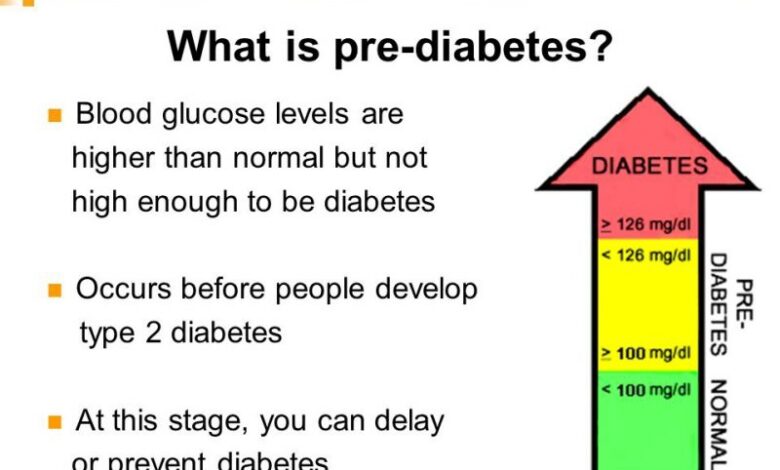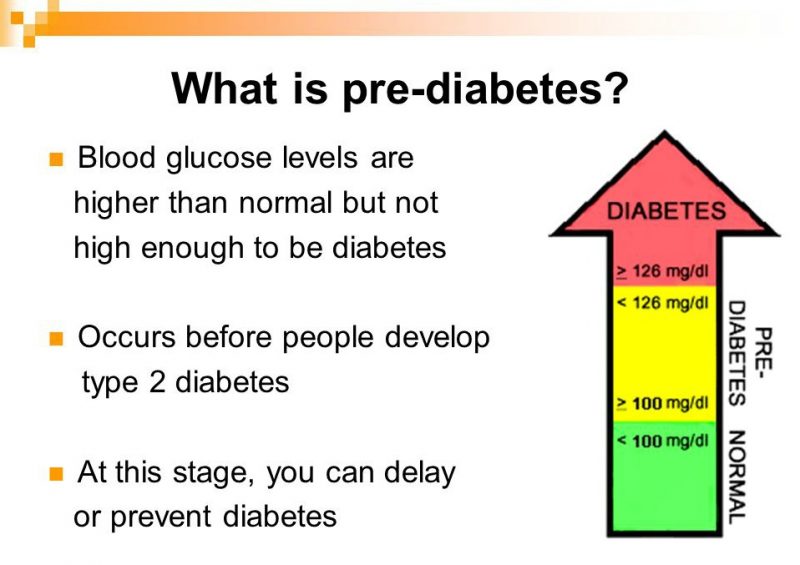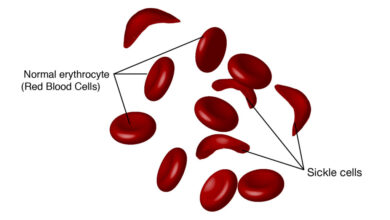
Normal blood sugar can hide prediabetes, a condition often overlooked yet significantly linked to the development of type 2 diabetes. Many individuals with prediabetes experience seemingly normal blood sugar levels, masking the underlying risk. This often leads to delayed diagnosis and a missed opportunity for early intervention and lifestyle adjustments. Understanding the subtle signs and potential consequences of this hidden condition is crucial for proactive health management.
This exploration dives deep into the often-misunderstood connection between seemingly normal blood sugar and the risk of prediabetes. We’ll unravel the factors that can mask this condition, examining the role of genetics, lifestyle choices, and other health conditions. The discussion will also highlight potential symptoms, early detection strategies, and effective lifestyle changes to prevent or manage prediabetes, even with normal blood sugar levels.
Introduction to Prediabetes and Normal Blood Sugar
Prediabetes is a condition where blood sugar levels are higher than normal but not high enough to be diagnosed as type 2 diabetes. This often goes unnoticed, as symptoms are frequently subtle or absent. Understanding the connection between seemingly normal blood sugar levels and the risk of prediabetes is crucial for early detection and prevention. Early intervention can significantly reduce the risk of developing type 2 diabetes and its associated health problems.The importance of understanding the subtle shifts in blood sugar levels cannot be overstated.
Many individuals with prediabetes experience no noticeable symptoms. This lack of immediate feedback can lead to a delay in diagnosis and subsequent health complications. Regular check-ups and awareness of risk factors are essential for proactive health management.
Characteristics of Prediabetes
Prediabetes is characterized by elevated blood glucose levels, typically between 100 and 125 mg/dL (fasting) or 140 to 199 mg/dL (two-hour postprandial). These levels are higher than normal but do not meet the diagnostic criteria for type 2 diabetes. Often, individuals with prediabetes have no symptoms. This makes early detection through regular blood sugar testing crucial.
Relationship to Normal Blood Sugar Levels
Normal blood sugar levels are essential for the body’s proper functioning. Blood sugar, or glucose, provides the energy cells need. The body carefully regulates blood sugar levels. Prediabetes represents a gradual decline in this regulation, increasing the risk of long-term complications. Understanding the normal range and how prediabetes deviates from it is vital for early detection and management.
Consequences of Undiagnosed Prediabetes
Undiagnosed prediabetes can lead to serious health consequences. It significantly increases the risk of developing type 2 diabetes, which can cause heart disease, stroke, nerve damage, kidney damage, and vision problems. Prolonged elevated blood sugar levels can also damage blood vessels and nerves. Early diagnosis and management are key to preventing these long-term health issues.
Comparison of Normal Blood Sugar and Prediabetes Blood Sugar Levels
| Characteristic | Normal Blood Sugar | Prediabetes Blood Sugar |
|---|---|---|
| Fasting Blood Sugar (mg/dL) | 70-99 | 100-125 |
| Two-Hour Postprandial Blood Sugar (mg/dL) | Less than 140 | 140-199 |
| Risk of Developing Type 2 Diabetes | Low | High |
| Symptoms | Usually absent | Usually absent |
| Importance of Monitoring | Regular check-ups recommended for individuals with risk factors. | Regular check-ups and blood sugar monitoring are crucial. |
Identifying the Hidden Risk Factors
Prediabetes, a condition where blood sugar levels are higher than normal but not yet high enough to be diagnosed as type 2 diabetes, often goes undetected. This is largely due to the fact that early stages of prediabetes may not manifest noticeable symptoms, and routine blood tests aren’t always part of a preventative health plan. Understanding the hidden risk factors that can mask prediabetes is crucial for early detection and intervention.This hidden risk is further complicated by the fact that individuals with seemingly normal blood sugar readings can still be at risk.
Factors like genetics, lifestyle choices, and even other underlying health conditions can influence blood sugar levels in subtle ways, leading to a misleading picture of metabolic health. By recognizing these factors, we can better equip ourselves to identify and address the potential for prediabetes before it progresses to a more serious condition.
Genetic Predisposition
Genetic factors play a significant role in determining an individual’s susceptibility to prediabetes. Family history of type 2 diabetes is a strong indicator of increased risk. Individuals with a family history of the disease may have a genetic predisposition to insulin resistance, a key factor in the development of prediabetes. This genetic predisposition can be exacerbated by environmental factors like diet and lifestyle.
Inherited variations in genes involved in glucose metabolism can influence how the body processes sugar, potentially leading to elevated blood sugar levels even with seemingly normal readings.
Lifestyle Factors
Certain lifestyle choices can significantly impact blood sugar levels, even if they don’t result in immediately noticeable symptoms. A diet high in processed foods, sugary drinks, and saturated fats can contribute to insulin resistance. Lack of physical activity reduces the body’s ability to utilize glucose effectively, further increasing the risk of prediabetes. Chronic stress can also influence blood sugar regulation, sometimes causing elevated blood sugar readings.
Other Health Conditions
Certain underlying health conditions can mask the presence of prediabetes, as these conditions can affect blood sugar levels in complex ways. For example, individuals with chronic kidney disease, or those with conditions affecting the digestive system, may experience subtle alterations in their glucose metabolism that are not easily detected. Similarly, certain medications, such as corticosteroids, can impact blood sugar control, potentially obscuring the early signs of prediabetes.
Examples of Concealed Prediabetes
Imagine a person with a family history of type 2 diabetes who regularly consumes a diet high in processed foods and lacks regular exercise. While their blood sugar levels may fall within the normal range during a single blood test, their cumulative lifestyle choices could still place them at significant risk for prediabetes. Similarly, someone with undiagnosed celiac disease might have normal blood sugar readings, yet their digestive issues could contribute to a subtle glucose intolerance.
Risk Factors and Potential Impact on Blood Sugar Levels
| Risk Factor | Potential Impact on Blood Sugar Levels |
|---|---|
| Family history of type 2 diabetes | Increased risk of insulin resistance and impaired glucose tolerance |
| Unhealthy diet (high in processed foods, sugar, saturated fats) | Reduced insulin sensitivity, potentially leading to elevated blood sugar levels over time |
| Lack of physical activity | Reduced glucose utilization, increasing the risk of impaired glucose metabolism |
| Chronic stress | Possible hormonal imbalances that can affect blood sugar regulation |
| Certain health conditions (e.g., chronic kidney disease, digestive issues) | Potential for subtle alterations in glucose metabolism that may mask prediabetes |
| Certain medications (e.g., corticosteroids) | Possible impact on blood sugar control, potentially obscuring the presence of prediabetes |
Symptoms and Early Detection

Prediabetes often sneaks up without obvious symptoms, making it challenging to identify early. While some individuals experience noticeable changes, many go undiagnosed, highlighting the critical role of regular checkups and screenings. Understanding potential signs and risk factors is crucial for proactive health management.Early detection is key to preventing prediabetes from progressing to type 2 diabetes, a serious condition impacting millions globally.
This proactive approach involves recognizing potential symptoms and taking necessary steps to manage risk factors.
Potential Symptoms
Often, prediabetes doesn’t manifest with clear, dramatic symptoms. Individuals might experience subtle changes that are easily overlooked or attributed to other factors. These subtle indications can include frequent urination, especially at night, increased thirst, and unexplained weight loss. Other possible symptoms can include blurry vision, slow-healing sores, and frequent infections.
Importance of Regular Checkups and Screenings
Regular checkups and screenings are essential for early detection. Routine blood tests, including fasting blood glucose tests, are crucial for identifying elevated blood sugar levels, a key indicator of prediabetes. These tests are generally recommended for individuals aged 45 or older, or those with risk factors like obesity or a family history of diabetes. Healthcare providers can assess individual risk factors and recommend appropriate screening schedules.
Risk Assessment Checklist
Identifying potential risk factors is critical in determining individual risk for prediabetes. Recognizing these factors allows for proactive measures and timely interventions. A comprehensive risk assessment can help determine the need for additional monitoring or lifestyle adjustments.
| Question | Answer | Risk Factor |
|---|---|---|
| Do you have a family history of type 2 diabetes? | Yes/No | Family history |
| Are you overweight or obese (BMI ≥ 25)? | Yes/No | Weight |
| Do you have high blood pressure (hypertension)? | Yes/No | Blood pressure |
| Do you have a history of gestational diabetes or delivered a baby weighing more than 9 lbs? | Yes/No | Gestational history |
| Do you have a sedentary lifestyle (limited physical activity)? | Yes/No | Lifestyle |
| Do you have high cholesterol or triglycerides? | Yes/No | Lipid profile |
| Are you age 45 or older? | Yes/No | Age |
| Do you have polycystic ovary syndrome (PCOS)? | Yes/No | PCOS |
| Have you had an A1c test in the past year? | Yes/No | Previous A1c test |
This checklist is for informational purposes only and should not be considered a substitute for professional medical advice. Always consult with your healthcare provider for personalized recommendations.
Lifestyle Changes and Management
Taking proactive steps to manage prediabetes, even if your blood sugar is currently normal, can significantly reduce your risk of developing type 2 diabetes and its associated complications. These lifestyle adjustments are not just about preventing disease; they can also improve overall health and well-being. Embracing a healthier lifestyle often leads to better energy levels, improved mood, and a stronger sense of overall wellness.Making gradual, sustainable changes is key to long-term success.
Focusing on small, manageable adjustments to your diet, exercise routine, and stress levels can yield substantial benefits over time. This proactive approach emphasizes empowering yourself with knowledge and tools to take control of your health.
Dietary Modifications
A balanced and nutritious diet is crucial for managing blood sugar levels. Prioritizing whole foods, limiting processed foods, and controlling portion sizes are essential strategies. The focus should be on foods that provide sustained energy without causing rapid spikes in blood sugar.
- Prioritize whole grains: Opt for whole-wheat bread, brown rice, quinoa, and oats over refined grains. These foods are rich in fiber, which helps slow down the absorption of sugar into the bloodstream, thus preventing those sharp blood sugar fluctuations.
- Increase fiber intake: Fiber-rich foods like fruits, vegetables, and legumes can help regulate blood sugar levels. Soluble fiber, in particular, helps lower cholesterol and promotes feelings of fullness, aiding in portion control.
- Choose lean protein sources: Lean meats, poultry without skin, fish, beans, and lentils are excellent sources of protein. These provide essential nutrients without excessive saturated fat, which can negatively impact blood sugar control.
- Control portion sizes: Pay attention to portion sizes to avoid overeating. Using smaller plates and bowls can help in achieving this.
- Limit processed foods, sugary drinks, and unhealthy fats: These foods can cause rapid increases in blood sugar, which can be detrimental to blood sugar control. Limit consumption of these items to occasional treats.
Exercise Routines
Regular physical activity plays a vital role in managing blood sugar levels. Exercise helps your body use insulin more effectively and improves insulin sensitivity.
- Aim for at least 150 minutes of moderate-intensity aerobic exercise per week: This can include brisk walking, swimming, cycling, or dancing. These activities improve cardiovascular health and help regulate blood sugar.
- Incorporate strength training exercises: Include weightlifting or resistance training exercises at least two times a week. Muscle tissue is metabolically active and helps regulate blood sugar levels.
- Find activities you enjoy: Choosing activities you find enjoyable makes exercise more sustainable in the long run. Experiment with different types of activities to discover what works best for you.
Stress Management Techniques
Chronic stress can negatively impact blood sugar control. Developing healthy stress management strategies is essential.
It’s easy to think your blood sugar is normal, but that doesn’t mean you’re not prediabetic. Just like a seemingly healthy appearance can mask underlying health issues, sometimes our bodies subtly signal trouble. This is a critical consideration, especially when you consider that the rising melanoma rates among young women are a serious concern, as explored in this fascinating article here.
Paying attention to the subtle signs of potential health problems, like those related to normal blood sugar, is key to maintaining overall well-being.
- Practice relaxation techniques: Techniques such as deep breathing exercises, meditation, yoga, or spending time in nature can help reduce stress levels.
- Prioritize sleep: Adequate sleep is crucial for regulating blood sugar levels and managing stress. Aim for 7-9 hours of quality sleep each night.
- Engage in activities you enjoy: Hobbies and interests can provide a sense of calm and reduce stress. Make time for activities that bring you joy.
Specific Dietary Recommendations
The following table Artikels specific dietary recommendations for individuals at risk of prediabetes. These recommendations provide a framework for creating a personalized meal plan.
It’s easy to think your blood sugar is normal, but sometimes prediabetes sneaks up on you. Just like how seemingly harmless habits can mask bigger issues, a seemingly normal blood sugar reading can actually hide prediabetes. This is something to be aware of, and understanding the factors that influence our health is crucial. For example, research into the correlation between substance use and driving safety is important, and studies like those exploring if marijuana use increases the risk of vehicle crashes can shed light on similar hidden risks.
does marijuana increase risk of vehicle crashes This highlights the importance of understanding how seemingly unrelated factors can affect our overall health and wellbeing, which is key to preventing the long-term implications of prediabetes. In short, maintaining good health awareness is key.
| Food Category | Specific Recommendations |
|---|---|
| Fruits and Vegetables | Prioritize a variety of colorful fruits and vegetables. Choose whole fruits over juices. |
| Grains | Choose whole grains over refined grains. Include oats, brown rice, and quinoa. |
| Protein | Choose lean protein sources like fish, poultry without skin, beans, and lentils. |
| Dairy and Alternatives | Choose low-fat or fat-free dairy options. Consider plant-based alternatives if needed. |
| Fats | Choose healthy fats like avocados, nuts, and seeds. Limit saturated and trans fats. |
| Sugary Foods and Drinks | Limit consumption of sugary foods and drinks. |
Medical Interventions
Managing prediabetes effectively often involves a combination of lifestyle changes and, in some cases, medical interventions. While lifestyle modifications are crucial for preventing the progression to type 2 diabetes, certain medications can play a significant role in maintaining healthy blood sugar levels and reducing the risk of long-term complications. Early intervention, when combined with healthy habits, can significantly improve outcomes.Medical interventions for prediabetes are typically considered when lifestyle changes alone aren’t sufficient to achieve and maintain target blood sugar levels.
These interventions are designed to prevent or delay the onset of type 2 diabetes, a serious condition that can lead to various health problems. A key aspect of medical interventions is their ability to improve insulin sensitivity and reduce glucose production by the liver.
Medications for Blood Sugar Control
Several medications are available to help manage prediabetes and prevent the progression to type 2 diabetes. These medications generally work by increasing insulin sensitivity, decreasing glucose production in the liver, or slowing the absorption of sugars from the intestines.
- Metformin is frequently prescribed for prediabetes. It works primarily by reducing glucose production in the liver and improving insulin sensitivity in the muscles. This medication is generally well-tolerated and is often the first-line treatment option for prediabetes.
- Other medications, such as sulfonylureas or GLP-1 receptor agonists, can also be considered in certain cases. These medications can stimulate insulin secretion from the pancreas or slow down the emptying of the stomach, respectively. However, they may have different side effects and are often used in conjunction with lifestyle changes or when metformin isn’t effective.
Other Treatments
Besides medications, other treatments can complement lifestyle modifications and medication regimens. These approaches can address potential contributing factors to prediabetes or help improve overall health.
It’s surprising how normal blood sugar levels can mask prediabetes, often leading to delayed diagnosis. While dealing with a stomach bug, I found myself researching the best remedies for stomach flu, best remedies for stomach flu , and the connection between gut health and overall well-being got me thinking. This got me wondering again about the subtle signs of prediabetes, and how easily they can be missed, even with seemingly normal blood sugar readings.
It’s a serious issue, and vigilance is key.
- Regular monitoring of blood sugar levels, often through home blood glucose testing and doctor-prescribed blood tests, allows for timely adjustments to treatment plans and ensures that the chosen strategies are effective.
- If other underlying conditions like high blood pressure or high cholesterol are present, addressing these issues through lifestyle changes and appropriate medications can positively influence prediabetes management.
Medical Intervention Strategies, Normal blood sugar can hide prediabetes
The table below summarizes various medical interventions used to manage prediabetes, highlighting their mechanisms of action and potential side effects. It’s crucial to remember that this is not an exhaustive list and that individual responses to treatments can vary. Consult a healthcare professional for personalized recommendations.
| Intervention | Mechanism of Action | Potential Side Effects |
|---|---|---|
| Metformin | Reduces glucose production in the liver, improves insulin sensitivity | Gastrointestinal upset (e.g., diarrhea, nausea), vitamin B12 deficiency (long-term use) |
| Sulfonylureas | Stimulates insulin secretion from the pancreas | Hypoglycemia (low blood sugar), weight gain |
| GLP-1 receptor agonists | Slows gastric emptying, increases insulin secretion, reduces appetite | Gastrointestinal side effects (e.g., nausea, vomiting, diarrhea), pancreatitis (rare) |
| Lifestyle modifications (diet and exercise) | Improve insulin sensitivity, reduce glucose absorption, promote weight loss | Requires commitment and effort to sustain long-term. Potential for short-term discomfort during lifestyle changes. |
Importance of Monitoring
Knowing you’re at risk for prediabetes requires a proactive approach. Simply acknowledging the possibility isn’t enough. Consistent monitoring, combined with lifestyle adjustments and regular check-ups, are crucial for managing and potentially reversing the condition. This proactive approach empowers you to take control of your health journey.Regular blood sugar monitoring allows you to track how your body responds to food, exercise, and stress.
These insights, when combined with professional guidance, provide valuable data for making informed decisions and tailoring a personalized plan for blood sugar management. Early detection and intervention are key to preventing the progression of prediabetes to type 2 diabetes.
Consistent Blood Sugar Monitoring
Regular blood sugar monitoring is essential for individuals at risk of prediabetes. It provides a real-time snapshot of your blood glucose levels, allowing you to identify patterns and trends. This data empowers you to make necessary lifestyle adjustments and helps you understand how different factors impact your blood sugar. By consistently tracking your readings, you gain valuable insights into your body’s response to various elements in your daily routine.
This allows you to correlate food choices, exercise routines, and stress levels with your blood glucose levels.
Regular Follow-up Appointments
Regular appointments with your healthcare professional are vital for monitoring your health and managing prediabetes. These appointments provide opportunities for personalized advice, support, and adjustments to your management plan. Your doctor can assess your progress, adjust medication (if necessary), and discuss any concerns or emerging issues. These consultations are crucial for ensuring that your plan remains effective and appropriate for your evolving needs.
They allow for a dynamic and adaptable approach to your management, ensuring the most effective strategies are implemented.
Maintaining a Healthy Lifestyle
Maintaining a healthy lifestyle is crucial for ongoing blood sugar management. A balanced diet, regular exercise, and stress management techniques are critical components of a holistic approach to prediabetes management. These strategies can help to regulate blood glucose levels and reduce the risk of developing type 2 diabetes. Consistent effort and a commitment to a healthier lifestyle are essential for long-term success.
Regular physical activity and stress reduction practices, alongside a nutritious diet, are crucial for optimal health and blood sugar control.
Sample Blood Sugar Monitoring Schedule
This table provides a sample schedule for blood sugar monitoring. Remember, this is a guideline, and your healthcare provider may recommend different frequencies based on your individual risk factors and circumstances. Adjustments to this schedule might be needed based on your particular situation.
| Day | Time | Action |
|---|---|---|
| Monday | Morning (fasting) | Check blood sugar |
| Tuesday | 2 hours after lunch | Check blood sugar |
| Wednesday | Before dinner | Check blood sugar |
| Thursday | Morning (fasting) | Check blood sugar |
| Friday | 2 hours after dinner | Check blood sugar |
| Saturday | Before lunch | Check blood sugar |
| Sunday | Before bedtime | Check blood sugar |
Illustrative Case Studies
Normal blood sugar readings can often mask the presence of prediabetes, a condition that significantly increases the risk of developing type 2 diabetes. Understanding the subtleties of this hidden risk is crucial for early detection and effective management. The following case studies illustrate scenarios where seemingly healthy individuals could have undiagnosed prediabetes.The challenge lies in the fact that prediabetes often doesn’t manifest with obvious symptoms.
Blood glucose levels are typically within the “normal” range, leading individuals to overlook the underlying metabolic changes occurring in their bodies. This makes early detection through regular screenings and awareness of risk factors critical.
Case Study 1: The “Healthy Eater”
Sarah, a 45-year-old woman, considers herself a health-conscious individual. She diligently follows a balanced diet rich in fruits and vegetables, and exercises regularly. However, she has a family history of type 2 diabetes, a significant risk factor. Her fasting blood glucose levels consistently fall within the normal range, yet she exhibits insulin resistance, a hallmark of prediabetes. Her body struggles to efficiently utilize insulin, leading to elevated blood glucose levels after meals.
This subtle dysfunction is not readily apparent through standard blood tests alone.
Case Study 2: The “Busy Professional”
Mark, a 30-year-old office worker, leads a demanding lifestyle. He often skips meals, relies heavily on processed foods, and finds it difficult to maintain a regular exercise routine. His blood sugar levels, measured during routine checkups, are typically within the normal range. However, his body’s ability to regulate blood glucose is compromised due to consistent high-stress levels and poor dietary habits.
This impaired regulation, though not immediately visible in a blood test, can indicate an underlying prediabetes condition.
Case Study 3: The “Athletes”
Two athletes, a 28-year-old female marathon runner (Emily) and a 35-year-old male weightlifter (David), have normal blood sugar levels during regular checkups. Emily’s rigorous training and carbohydrate-rich diet, while beneficial for athletic performance, can also elevate blood sugar levels post-meal. David’s intense weightlifting training can cause insulin resistance, even with a seemingly balanced diet. Both, however, could have underlying prediabetes due to their specific lifestyle and activity levels.
Comparison of Case Study Characteristics
| Characteristic | Case Study 1 (Healthy Eater) | Case Study 2 (Busy Professional) | Case Study 3 (Athletes) |
|---|---|---|---|
| Age | 45 | 30 | 28/35 |
| Lifestyle | Health-conscious, balanced diet, regular exercise | Demanding, irregular meals, limited exercise, high stress | Rigorous training, potential carbohydrate-rich diet, high activity level |
| Family History of Diabetes | Yes | No | No |
| Symptoms | None (yet) | None (yet) | None (yet) |
| Blood Glucose Levels | Normal fasting | Normal fasting | Normal fasting |
| Underlying Issue | Insulin resistance | Impaired glucose regulation | Potential insulin resistance/high blood glucose post-meal |
Visual Representation of Blood Sugar Levels: Normal Blood Sugar Can Hide Prediabetes
Understanding blood sugar levels is crucial for managing prediabetes and preventing the progression to type 2 diabetes. Visual representations of these levels provide a clear picture of how blood sugar fluctuates over time, aiding in identifying patterns and making informed decisions about lifestyle changes or medical interventions. This section will explore how blood sugar is measured, presented visually, and used to track progress.
Measuring and Presenting Blood Sugar Levels
Blood sugar levels are typically measured in milligrams per deciliter (mg/dL). A blood glucose test, often a simple finger-prick test, measures the amount of glucose in the blood at a specific point in time. These readings are crucial for assessing overall blood sugar control. Continuous glucose monitoring (CGM) systems provide a more comprehensive view by recording glucose levels continuously throughout the day and night.
This continuous data allows for a more detailed analysis of blood sugar patterns, including trends and fluctuations.
Visual Representations of Blood Sugar Levels
Various graphical representations illustrate blood sugar levels. Line graphs are common, displaying blood sugar levels over time. The x-axis typically represents time (hours, days, or weeks), and the y-axis displays the blood sugar readings in mg/dL. A line graph can effectively highlight trends, such as rising or falling blood sugar levels. Bar graphs can also be used to represent blood sugar levels, comparing different time points or days.
Area charts can be used to visualize the cumulative effect of blood sugar levels over time.
Blood Sugar Levels Over Time (Illustrative Example)
This table demonstrates blood sugar levels for an individual over a period of a week. The data is hypothetical but represents typical fluctuations.
| Day | Time (hours) | Blood Sugar (mg/dL) |
|---|---|---|
| Monday | 8:00 AM | 95 |
| Monday | 12:00 PM | 110 |
| Monday | 4:00 PM | 125 |
| Monday | 8:00 PM | 100 |
| Tuesday | 8:00 AM | 98 |
| Tuesday | 12:00 PM | 105 |
| Tuesday | 4:00 PM | 118 |
| Tuesday | 8:00 PM | 92 |
| Wednesday | 8:00 AM | 90 |
| Wednesday | 12:00 PM | 102 |
| Wednesday | 4:00 PM | 110 |
| Wednesday | 8:00 PM | 95 |
The table above presents a sample of blood sugar readings. Regular monitoring, visualized in various forms, helps individuals understand their blood sugar patterns, which are critical for making informed decisions about diet, exercise, and medication.
Normal vs. Prediabetes Blood Sugar Levels (Visual Comparison)
A visual representation can highlight the difference between normal and prediabetes blood sugar levels. A line graph displaying blood sugar readings over time can show if the readings consistently fall within the normal range or frequently fall above the prediabetes range. Different colors or shading can be used to visually differentiate normal from prediabetes ranges. Normal blood sugar levels are generally below 100 mg/dL, while prediabetes ranges typically from 100-125 mg/dL.
Closure

In conclusion, understanding that normal blood sugar can conceal prediabetes is vital for proactive health management. By recognizing the risk factors, potential symptoms, and the importance of regular checkups and screenings, individuals can take proactive steps towards early detection and effective management. Implementing lifestyle changes and seeking medical interventions, when necessary, can significantly reduce the risk of prediabetes progressing to type 2 diabetes.
Remember, consistent monitoring and a healthy lifestyle are key to maintaining optimal blood sugar levels and overall well-being.





